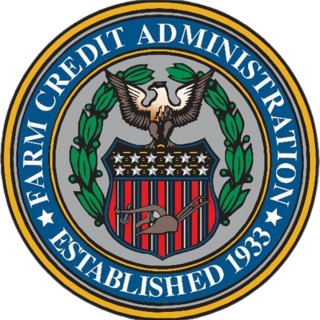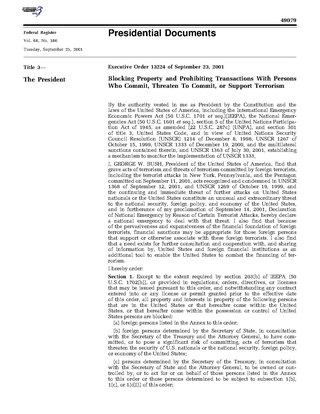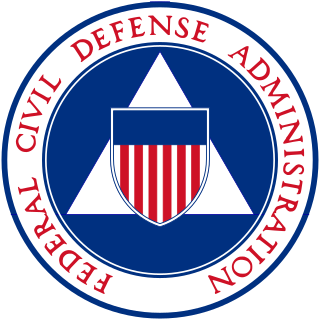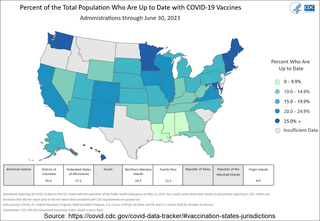Continuity of Operations (COOP) is a United States federal government initiative, required by U.S. Presidential Policy Directive 40 (PPD-40), to ensure that agencies are able to continue performance of essential functions under a broad range of circumstances. PPD-40 specifies certain requirements for continuity plan development, including the requirement that all federal executive branch departments and agencies develop an integrated, overlapping continuity capability, that supports the eight National Essential Functions (NEFs) described in the document.

The Farm Credit Administration is an independent agency of the federal government of the United States. Its function is to regulate the financial institutions that provide credit to farmers.

The United States Department of Homeland Security (DHS) is the U.S. federal executive department responsible for public security, roughly comparable to the interior or home ministries of other countries. Its stated missions involve anti-terrorism, border security, immigration and customs, cyber security, and disaster prevention and management.

Federal Emergency Management Agency (FEMA) is an agency of the United States Department of Homeland Security (DHS), initially created under President Jimmy Carter by Presidential Reorganization Plan No. 3 of 1978 and implemented by two Executive Orders on April 1, 1979. The agency's primary purpose is to coordinate the response to a disaster that has occurred in the United States and that overwhelms the resources of local and state authorities. The governor of the state in which the disaster occurs must declare a state of emergency and formally request from the President that FEMA and the federal government respond to the disaster. The only exception to the state's gubernatorial declaration requirement occurs when an emergency or disaster takes place on federal property or to a federal asset—for example, the 1995 bombing of the Alfred P. Murrah Federal Building in Oklahoma City, Oklahoma, or the Space Shuttle Columbia in the 2003 return-flight disaster.

In the United States, an executive order is a directive by the president of the United States that manages operations of the federal government. The legal or constitutional basis for executive orders has multiple sources. Article Two of the United States Constitution gives presidents broad executive and enforcement authority to use their discretion to determine how to enforce the law or to otherwise manage the resources and staff of the executive branch. The ability to make such orders is also based on expressed or implied Acts of Congress that delegate to the president some degree of discretionary power. The vast majority of executive orders are proposed by federal agencies before being issued by the president.

The United States Secretary of Homeland Security is the head of the United States Department of Homeland Security, the federal department tasked with ensuring public safety in the United States. The secretary is a member of the Cabinet of the United States. The position was created by the Homeland Security Act following the attacks of September 11, 2001.

The Office of Foreign Assets Control (OFAC) is a financial intelligence and enforcement agency of the U.S. Treasury Department. It administers and enforces economic and trade sanctions in support of U.S. national security and foreign policy objectives. Under Presidential national emergency powers, OFAC carries out its activities against foreign states as well as a variety of other organizations and individuals, like terrorist groups, deemed to be a threat to U.S. national security.
Executive Order 12148 was an executive order enacted by President Jimmy Carter on July 20, 1979, to transfer and reassign duties to the newly formed agency, known as the Federal Emergency Management Agency (FEMA), created by Executive Order 12127. The order combined several federal agencies tasked with emergency preparedness and civil defense spread across the executive departments into a unified entity that was established as an independent agency, free of Cabinet interference, with authority as the lead federal agency in a presidentially-declared disaster.

Executive Order 13224 is an executive order issued by U.S. President George W. Bush on September 23, 2001, as a response to the attacks on September 11, 2001. It has been renewed every year since.

The Federal Civil Defense Administration (FCDA) was organized by President Harry S. Truman on December 1, 1950, through Executive Order 10186, and became an official government agency via the Federal Civil Defense Act of 1950 on 12 January 1951. In 1958 the FCDA was superseded by the Office of Civil and Defense Mobilization when President Dwight D. Eisenhower merged the FCDA with the Office of Defense Mobilization.
The powers of the president of the United States include those explicitly granted by Article II of the United States Constitution as well as those granted by Acts of Congress, implied powers, and also a great deal of soft power that is attached to the presidency.
The unitary executive theory is a normative theory of United States constitutional law which holds that the President of the United States possesses the power to control the entire federal executive branch. The doctrine is rooted in Article Two of the United States Constitution, which vests "the executive Power" of the United States in the President.
Executive Order 11921 was an executive order approved by President of the United States Gerald Ford on June 11, 1976. It amends Executive Order 11490 of October 28, 1969, which calls for federal agencies to prepare plans for a state of emergency that would require "over-all civilian manpower mobilization programs" and related emergency measures.

Executive Order 13087 was signed by U.S. President Bill Clinton on May 28, 1998, amending Executive Order 11478 to prohibit discrimination based on sexual orientation in the competitive service of the federal civilian workforce. The order also applies to employees of the government of the District of Columbia, and the United States Postal Service. However, it does not apply to positions and agencies in the excepted service, such as the Central Intelligence Agency, National Security Agency, and the Federal Bureau of Investigation.
The Office of Defense Mobilization (ODM) was an independent agency of the United States government whose function was to plan, coordinate, direct and control all wartime mobilization activities of the federal government, including manpower, economic stabilization, and transport operations. It was established in 1950, and for three years was one of the most powerful agencies in the federal government. It merged with other agencies in 1958 to become the Office of Civil and Defense Mobilization (1958–1961).
The National Security and Homeland Security Presidential Directive, signed by President of the United States George W. Bush on May 4, 2007, is a Presidential Directive establishing a comprehensive policy on the federal government structures and operations in the event of a "catastrophic emergency". Such an emergency is defined as "any incident, regardless of location, that results in extraordinary levels of mass casualties, damage, or disruption severely affecting the U.S. population, infrastructure, environment, economy, or government functions."
The Plan for the Security Control of Air Traffic and Air Navigation Aids (SCATANA) is an emergency preparedness plan of the United States which prescribes the joint action to be taken by appropriate elements of the Department of Defense, Federal Aviation Administration, and the Federal Communications Commission in the interest of national security in order to effectively control air traffic and air navigation aids under emergency conditions. Known versions of the plan are dated June 1971 and August 1975. The plan implements parts of the Federal Aviation Act of 1958, the Communications Act of 1934, and Executive Order 11490 of October 28, 1969.
The Fair Employment Practice Committee (FEPC) was created in 1941 in the United States to implement Executive Order 8802 by President Franklin D. Roosevelt "banning discriminatory employment practices by Federal agencies and all unions and companies engaged in war-related work." That was shortly before the United States entered World War II. The executive order also required federal vocational and training programs to be administered without discrimination. Established in the Office of Production Management, the FEPC was intended to help African Americans and other minorities obtain jobs in home front industries during World War II. In practice, especially in its later years, the committee also tried to open up more skilled jobs in industry to minorities, who had often been restricted to lowest-level work. The FEPC appeared to have contributed to substantial economic improvements among black men during the 1940s by helping them gain entry to more skilled and higher-paying positions in defense-related industries.

The COVID-19 vaccination campaign in the United States is an ongoing mass immunization campaign for the COVID-19 pandemic in the United States. The Food and Drug Administration (FDA) first granted emergency use authorization to the Pfizer–BioNTech vaccine on December 10, 2020, and mass vaccinations began four days later. The Moderna vaccine was granted emergency use authorization on December 17, 2020, and the Janssen vaccine was granted emergency use authorization on February 27, 2021. By April 19, 2021, all U.S. states had opened vaccine eligibility to residents aged 16 and over. On May 10, 2021, the FDA approved the Pfizer-BioNTech vaccine for adolescents aged 12 to 15. On August 23, 2021, the FDA granted full approval to the Pfizer–BioNTech vaccine for individuals aged 16 and over.








